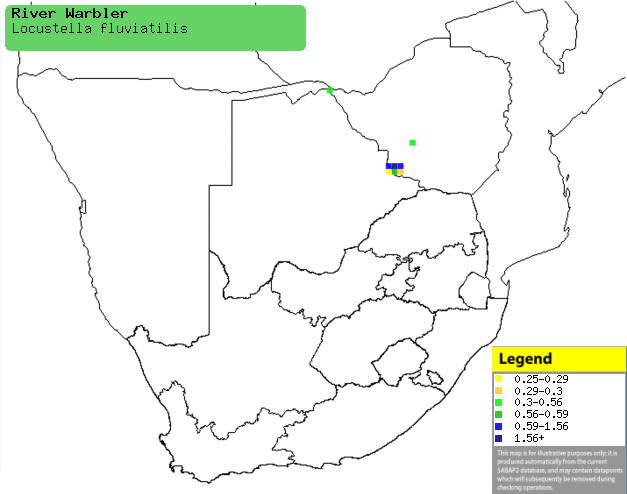|
Locustella fluviatilis (River
warbler)
Sprinkaansanger [Afrikaans]; Krekelzanger [Dutch];
Locustelle fluviatile [French]; Schlagschwirl [German]; Felosa-fluvial
[Portuguese]
Life
> Eukaryotes >
Opisthokonta
> Metazoa (animals) >
Bilateria >
Deuterostomia > Chordata >
Craniata > Vertebrata (vertebrates) > Gnathostomata (jawed
vertebrates) > Teleostomi (teleost fish) > Osteichthyes (bony fish) > Class:
Sarcopterygii (lobe-finned
fish) > Stegocephalia (terrestrial
vertebrates) > Tetrapoda
(four-legged vertebrates) > Reptiliomorpha > Amniota >
Reptilia (reptiles) >
Romeriida > Diapsida > Archosauromorpha > Archosauria >
Dinosauria
(dinosaurs) > Saurischia > Theropoda (bipedal predatory dinosaurs) >
Coelurosauria > Maniraptora > Aves
(birds) > Order: Passeriformes
> Family: Sylviidae
Distribution and habitat
Its breeding grounds are from eastern Germany to Russia,
north to Finland and south to Romania. In the non-breeding season it flies all
the way to Zambia, north-western Mozambique, Zimbabwe, Botswana and
north-eastern South Africa (note that the map pictured below does not include
many records from these countries). In southern Africa it is rare and localised,
preferring mature Miombo (Brachystegia) and Zambezi teak (Baikiaea
plurijuga) woodland with extremely dense undergrowth. It is very shy and
difficult to see, as it favours dense bushes such as num-nums (Carissa)
and grewias (Grewia).
|
 |
|
Distribution of River warbler in southern Africa,
based on statistical smoothing of the records from first SA Bird Atlas
Project (©
Animal Demography unit, University of
Cape Town; smoothing by Birgit Erni and Francesca Little). Colours range
from dark blue (most common) through to yellow (least common).
See here for the latest distribution
from the SABAP2. |
Movements and migrations
It arrives in southern Africa around
January-February, with each bird settling in roughly the same area
as the previous seasons. It leaves after the first cold, cloudless
night, usually in late March to early April.
Food
It mainly eats arthropods, doing most of its foraging on
the ground, occasionally plucking insects from nearby leaves. A wide variety of
prey have been recorded in its diet in Eurasia, but the only recorded prey in
southern Africa are fruit-flies (Tephritidae).
References
-
Hockey PAR, Dean WRJ and Ryan PG 2005. Roberts
- Birds of southern Africa, VIIth ed. The Trustees of the John Voelcker
Bird Book Fund, Cape Town.
|
